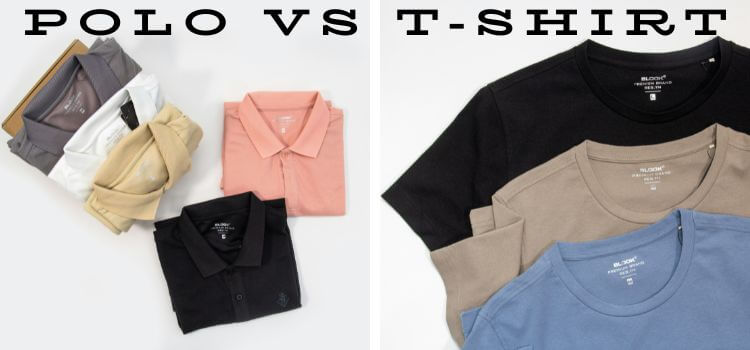As an Amazon Associate I earn from qualifying purchases.

Casually, polos and t-shirts have been staples for decades. These two types of tops have unique appeal and purpose, making them go-to choices for many men and women worldwide.
When it comes to deciding between a polo and a T-shirt, understanding their differences and knowing which one best suits your needs can make all the difference in your wardrobe.
This comprehensive guide will break down the nuances between polo shirts and t-shirts, helping you make the right choice for every occasion.
What is a Polo Shirt?
A polo shirt is a short-sleeved, collared shirt that usually features two or three buttons at the neck. Polos are traditionally made from knitted cotton fabrics like pique or jersey.
They offer a mix of comfort and elegance, making them appropriate for everyday wear and more polished and casual settings.
A polo shirt is known for its unique collar and placket, which is an opening with buttons.
Key Characteristics of Polo Shirts
Collar and Placket: The hallmark of a polo shirt is its soft collar, which can be buttoned up or left open for a more relaxed look.
Breathable Fabric: Usually crafted from cotton or cotton blends, polos provide excellent breathability, perfect for warm weather or active settings.
Tailored Fit: Polos often come in a slightly fitted style, giving a more tailored appearance compared to regular t-shirts.
Versatility: They can be worn with anything from jeans and shorts to chinos and blazers, making them ideal for both casual and business-casual environments.
What is a T-shirt?
A t-shirt is a simple, collarless shirt that is generally made from cotton or cotton blends. It is a wardrobe essential known for its comfort, versatility, and ease of wear. T-shirts are incredibly popular for their simplicity and are available in countless styles, colors, and prints.
Key Characteristics of T-Shirts
No Collar: Unlike polos, t-shirts are collarless, giving them a more laid-back and relaxed appearance.
Variety of Styles: From crew neck and V-neck to long sleeves and graphic tees, t-shirts offer endless choices for personal expression.
Comfortable and Casual: T-shirts are designed for comfort and are suitable for almost any casual setting.
Affordable and Easy to Maintain: Generally, t-shirts are more budget-friendly and easier to care for compared to polo shirts.
Polo vs T-Shirt: Fabric and Comfort
When comparing polo shirts and t-shirts, one of the most significant factors is the fabric and comfort. T-shirts are typically made from 100% cotton or cotton blends, which are recognized for their gentleness and coziness. They are well-suited for relaxing, managing errands, or casual meet-ups.
On the other hand, polo shirts are often made from pique cotton, which is a bit heavier and more textured than the fabric used in t-shirts. This makes polos slightly more structured and less casual than t-shirts.
However, the breathability of the material and the tailored fit of polos provide a polished look that can easily transition from a casual to a semi-formal environment.
Which is More Comfortable?
For sheer comfort, t-shirts generally take the lead due to their lightweight and soft fabric. However, if you’re looking for something that offers comfort with a touch of sophistication, polo shirts are the better choice.
Style and Versatility: When to Wear Polos vs T-Shirts
The choice between a polo and a T-shirt often boils down to the occasion and personal style preferences.
When to Wear a Polo Shirt
Business Casual Settings: Polos are an excellent choice for business-casual environments. Pair them with chinos or dress pants for a polished look.
Outdoor Events: The breathability and tailored fit of polos make them ideal for outdoor events like golf outings, casual dinners, or summer parties.
Smart Casual: Polos can also be dressed up with a blazer and jeans for a smart-casual ensemble that is both comfortable and stylish.
When to Wear a T-Shirt
Everyday Casual Wear: T-shirts are perfect for daily wear, whether you’re hanging out at home, running errands, or going for a casual outing.
Layering: T-shirts work well as a base layer under jackets, cardigans, or flannel shirts, offering both style and comfort.
Sporty and Active Settings: For workouts, sports, or outdoor activities, a simple cotton t-shirt is often the go-to choice for its comfort and breathability.
Polo vs T-Shirt: Formality and Appearance
One of the key distinctions between polo shirts and t-shirts is their level of formality. Polos are seen as more refined and formal compared to the laid-back look of t-shirts.
Why Choose a Polo for a Semi-Formal Look?
Polos bridge the gap between casual and formal. They are more casual than a dress shirt but more refined than a t-shirt. A polo shirt can effortlessly elevate an outfit, making it suitable for office settings, casual business meetings, or social gatherings where a touch of refinement is needed.
Why Choose a T-Shirt for a Relaxed Look?
A T-shirt is synonymous with casual wear. Its relaxed fit and lack of a collar make it the ideal choice for scenarios where comfort and informality are the priorities. From beach outings to weekend get-togethers, t-shirts are the epitome of laid-back style.
Fit and Body Type Considerations
Both polo shirts and t-shirts come in various fits and styles, making it crucial to choose the one that best suits your body type.
Polos and Body Type
Slim Fit Polos: Ideal for those with lean or athletic builds. The fitted cut accentuates the body shape.
Regular Fit Polos: Suitable for most body types, providing a balanced look that is neither too tight nor too loose.
Big and Tall Polos: For those with larger frames, polos designed specifically for big and tall sizes offer comfort without compromising on style.
T-Shirts and Body Type
Fitted T-Shirts: A snug fit that suits slimmer individuals, highlighting their physique.
Regular Fit T-Shirts: A standard cut that works well for most body types, offering comfort without being too loose.
Oversized T-Shirts: Popular for streetwear styles and suitable for a more relaxed, casual look.
Durability and Maintenance
When it comes to durability and maintenance, both polo shirts and t-shirts have their advantages and considerations.
Durability of Polo Shirts
Higher Durability: Due to their thicker fabric and structured design, polo shirts often last longer than t-shirts.
Requires Gentle Care: Polos need to be washed with care to maintain their shape and avoid shrinking. It’s preferable to avoid using high temperatures in the dryer.
Durability of T-Shirts
Easy to Maintain: T-shirts are generally low-maintenance and can be machine-washed and dried without much concern.
Prone to Wear and Tear: Over time, t-shirts can show signs of wear, especially if they are made from thinner fabrics.
Cost Comparison: Polos vs T-Shirts
The price difference between polos and t-shirts can also play a role in your decision. T-shirts are usually more budget-friendly, with costs ranging from a few dollars up to about $30 for high-end options.
Polos, on the other hand, tend to be on the pricier side due to their more complex design and fabric. A high-quality polo shirt can cost between $20 and $100 or more, depending on the brand and fabric.
Polo or T-Shirt – Which One is Right for You?
Ultimately, the choice between a polo shirt and a t-shirt comes down to personal preference, style, and the occasion.
If you need a versatile top that can transition seamlessly from a casual day out to a business casual setting, a polo shirt is a fantastic option. However, if comfort, simplicity, and ease of styling are your main priorities, a t-shirt remains an unbeatable choice.
Whether you opt for a polo or a T-shirt, both have their place in a well-rounded wardrobe. Understanding the differences between these two options can help you make better choices and feel confident in whatever you wear.
Amazon and the Amazon logo are trademarks of Amazon.com, Inc, or its affiliates.




Leave a Reply